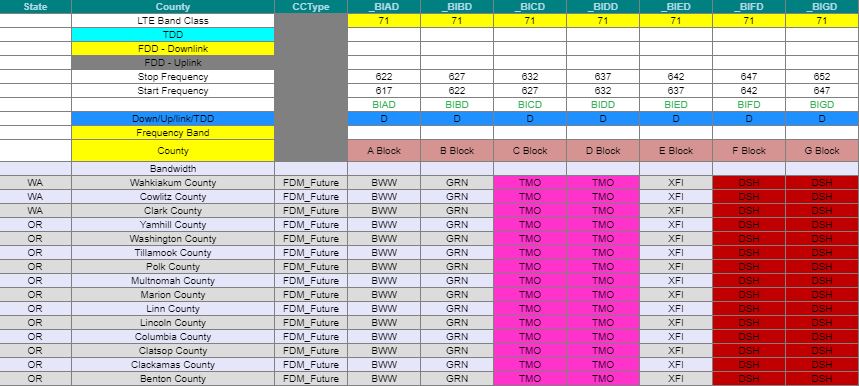Free Shipping On world wide
- HOME
- PRODUCTS
- IN THE NEWS
- SPECTRUM BLOG
- WEB SPECTRUM VIEWER
-
English
-
USD
Free Shipping On world wide
In Fierce Wireless' article on T-Mobile's initial lease of Comcast's 600MHz spectrum, there were 3 markets highlighted as "required" as part of the purchase agreement. These three markets are New York City, Orlando, and Kansas City. In this post we want to examine the effect on the effective Band 71 NR channel size that T-Mobile will be utilizing for their low band 5G network in these markets.
To see all of the markets where Comcast has 600MHz spectrum, we will utilize our Web Spectrum Viewer - Mapping.
Comcast 600MHz Licenses:

A simple way to view the current and the new channel size is to view T-Mobile and Comcast's 600MHz licenses in our Web Spectrum Viewer - Spectrum Grid.
New York PEA Market Licenses:
In the New York market, T-Mobile currently controls 2x15MHz of spectrum enabling a 15MHz uplink and downlink channel. With the addition of Comcast's adjacent A block spectrum T-Mobile will be able to increase their channel size in the 600MHz band to 20MHz.

Kansas City PEA Market Licenses:
In the Kansas City market, T-Mobile currently controls 2x15MHz of spectrum enabling a 15MHz uplink and downlink channel. With Comcast's E block spectrum T-Mobile will be able to increase their channel size in the 600MHz band to 20MHz.

Orlando PEA Market Licenses:
In the Orlando market, T-Mobile currently controls 2x10MHz of spectrum enabling a 10MHz uplink and downlink channel. With Comcast's E block spectrum T-Mobile will be able to increase their channel size in the 600MHz band to 15MHz.









Last week we began to see announcements from the FCC authorizing a series of temporary spectrum usage agreements to provide additional spectrum to several of the wireless operators to increase network capacity as workers are dispatched to their homes.
We will look at the effect of these agreements in a few markets to see how they are increasing LTE capacity. The analysis will be supported with outputs from our Mobile Carrier - Spectrum Ownership Analysis Tool specifically the Spectrum Ownership Grid.
T-Mobile 600MHz Capacity Expansion:
The first agreement provides T-Mobile with access to 600MHz spectrum from Bluewater Wireless, Channel 51 LIcense Co and LB License Co (Columbia Capital), CC Wireless Investment (Comcast), ParketB.com Wireless (Dish), New Level (Grain), and Tstar License Holdings (Tri-Star).
In the image below for the New York CMA market, T-Mobile will have access to Comcast's spectrum (XFI) and Dish's spectrum increasing their 600MHz channel size in New York from 10MHz channel to a 20MHz channel. T-Mobile would have access to the entire 35MHz of spectrum so they could provide a 20MHz channel and a 10MHz channel for capacity. Because T-Mobile has already deployed Band 71 equipment in New York, they can turn up the expanded spectrum without additional equipment installations.
USCellular AWS-3 Capacity Expansion:
The next agreement provides USCellular access to AWS-3 spectrum from their bidding partner Advantage Spectrum. In the image below a few of the Washington markets where USCellular will access AWS-3 spectrum are indicated. In most of these markets, USCellular currently operates on their cellular frequencies but doesn't have Band 66 operations.Thus, USCellular will need to add base stations and antennas to their sites for Band 66 to utilize these new frequencies. In five of these counties USCellular is likely operating on AWS-1 spectrum in Band 66 so the spectrum will be easier to deploy in those counties.
Verizon AWS-3 Capacity Expansion:
In the image below we illustrate the AWS-3 spectrum that Verizon will gain temporary access from SNR License Co and Northstar Wireless (both Dish partners). Northstar controls the AWS-3 G channel and SNR LIcense Co controls the AWS-3 H channel. In the New York market, Northstar Wireless owns the G block spectrum and SNR Wireless owns the H block spectrum. Accessing this spectrum will provide Verizon a second Band 66 LTE channel, increasing their LTE capacity from 20MHz to 30MHz.
Verizon & AT&T AWS-3 Capacity Expansion:
Verizon and AT&T have also requested access to the spectrum that Northstar Wireless and SNR Wireless returned to the FCC when their auction discounts were eliminated. The AWS-3 spectrum depth that is "unassigned" is indicated in the map below. In our data, we reflect these unassigned licenses with the FCC heading.
AT&T requested the I block spectrum in the New York market, so it will expand their Band 66 LTE from 10MHz to 15MHz. The markets AT&T requested are listed here and the markets that Verizon requested are here.
AT&T AWS-4 Capacity Expansion:
AT&T has also requested access to Dish's Band 66 spectrum. From the image above AT&T can expand their Band 66 LTE by and additional 5MHz to 20MHz by using part of Dish's AWS-4 spectrum. AT&T will still have an additional 15MHz of Dish's spectrum that they could use as an additional LTE channel in New York. AT&T only requested access to Dish's Band 66 spectrum, not their Band 70 AWS-4 spectrum.
AT&T 700MHz E-block Expansion:
Dish also reported that AT&T requested access the the 700MHz E-block in the markets that AT&T doesn't own. In the image below, Dish's ownership in Chicago and Detroit will provide AT&T the capability to expand their Band 29 supplemental downlink from 5MHz to 10MHz.